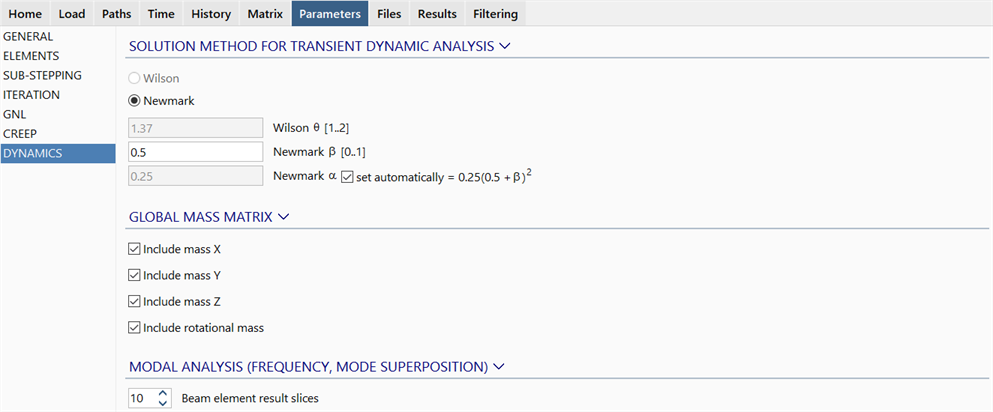SOLVERS Parameters: DYNAMICS

Description
Set the parameters that apply to the dynamic solvers.
SOLUTION METHOD FOR TRANSIENT DYNAMIC ANALYSIS
Method
Specifies which of the two integration methods is to be used: Wilson or Newmark. Default values for the integration constants in these two methods can be used for most problems. Note that only the Newmark option is available for nonlinear transient analyses.
-
Wilson θ
This parameter is the integration constant in the Wilson scheme. By default, it is set to 1.37, but may be any value between 1.0 and 2.0.
-
Newmark b
This parameter is an integration constant in the Newmark scheme. By default, it is set to 0.5, but may be any value between 0 and 1.0. Setting a value greater than 0.5 will induce artificial damping in the system. Setting the value less than 0.5 will induce negative damping which is analogous to a progressive increase in the energy of the system.
-
Newmark a
This parameter is an integration constant in the Newmark scheme typically related to the b constant.
-
set automatically
If set, this value is evaluated according to
.
-
GLOBAL MASS MATRIX
Mass Components
Options to include or exclude components of mass in the three global axes are available. All mass components are included by default. If the contribution of mass in one of the axes is excluded, the translational mass in that axis and the rotational mass about the other two axes will be set to zero. For example if X is unchecked, the translational mass in X and rotational mass about Y and Z will be set to zero in the mass matrix. The others are obtained by cyclic rotation.
Include Rotational Mass
If set, the rotational mass components are assembled into the mass matrix; if not set, only the translational mass degrees of freedom are assembled. Whilst all mass degrees of freedom should be included to fully describe the inertia characteristics of elements with rotational degrees of freedom (e.g., beams and plates), it is sometimes useful to ignore these, for example, in a frame analysis where the torsional vibration of beam elements is to be excluded from the analysis.
MODAL ANALYSIS (FREQUENCY, MODE SUPERPOSITION)
This option sets the number of slices (stations) along which force and moment results on beam elements will be evaluated in the Natural Frequency, Harmonic Response and Spectral Response solvers. The number of slices remains fixed for post-processing, and intermediate values are linearly interpolated between the values at the solver-calculated stations.
In the Linear Static solver, as well as in the Nonlinear Static, Quasi-static and Transient Dynamic solvers with linear beam materials, the number of slices can be changed and the results calculated at each slice during post-processing. This is because these solvers calculate only the end values of the beam results, when the beam material is linear, and the post-processor determines the force/moment distribution along the beam by considering the end values together with the applied element loads.
See Also